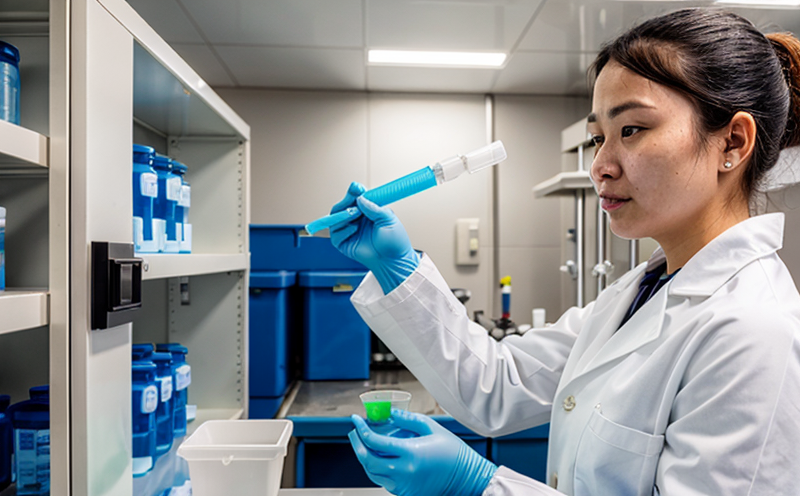USP Antimicrobial Susceptibility Testing
The United States Pharmacopeia (USP) Antimicrobial Susceptibility Testing is a critical component of ensuring product quality and safety in the pharmaceutical industry. This testing ensures that antimicrobial agents are effective against targeted microorganisms, thereby supporting the efficacy and safety of pharmaceutical products.
Antimicrobial susceptibility testing evaluates how well an antibiotic or other antimicrobial agent works against specific pathogens. It helps to identify potential issues early on in the development process, ensuring compliance with regulatory standards and facilitating informed decision-making regarding product formulation and labeling.
The USP provides detailed guidelines for conducting this test, which are based on international best practices and scientific evidence. These guidelines ensure that all labs performing these tests follow consistent procedures, enhancing reliability across different facilities.
At our laboratory, we utilize advanced technology and methodologies to perform USP antimicrobial susceptibility testing accurately and efficiently. Our state-of-the-art equipment allows us to analyze various types of specimens from diverse sources, including cultures derived directly from patients or environmental samples. This capability ensures that the results obtained are representative of real-world conditions.
We pride ourselves on our commitment to accuracy and precision in every aspect of our work. By leveraging cutting-edge technology and adhering strictly to USP specifications, we strive to deliver reliable outcomes that meet or exceed industry expectations. Our experienced technicians and scientists bring extensive knowledge and expertise to each project they undertake, ensuring high-quality results.
The importance of this testing cannot be overstated as it plays a crucial role in safeguarding public health by preventing the spread of resistant bacteria through effective treatment regimens. Ensuring that antimicrobial agents remain potent against target organisms is essential for maintaining the effectiveness of medical therapies worldwide.
Applied Standards
The USP Antimicrobial Susceptibility Testing follows closely with several internationally recognized standards, including those established by ISO (International Organization for Standardization), ASTM International, and EN (European Norms). These organizations set benchmarks that help ensure consistency in methodology across various laboratories.
For instance, the USP guidelines specify specific culture media and growth conditions required for each type of microorganism being tested. This ensures that all labs conducting these tests follow consistent procedures, leading to more accurate results. Additionally, the USP recommends using standardized breakpoints which define when an antimicrobial is considered effective or ineffective against a given pathogen.
These standards are crucial because they provide clear instructions on how to perform each step of the test correctly. They also help prevent errors that could lead to incorrect conclusions about drug efficacy or safety. By adhering strictly to these guidelines, we can ensure our findings are valid and reliable.
Our laboratory has invested significantly in training its personnel to understand not just the technical aspects but also the broader implications of following such stringent protocols. This commitment ensures that all tests conducted here meet both local regulatory requirements as well as international standards.
Competitive Advantage and Market Impact
The ability to perform USP antimicrobial susceptibility testing accurately and consistently offers significant competitive advantages in today's highly regulated pharmaceutical market. Regulatory authorities expect manufacturers to demonstrate compliance with established guidelines, making this capability essential for maintaining certifications and approvals.
By offering this service, our laboratory can contribute directly towards ensuring product quality and safety throughout the supply chain. This not only enhances customer confidence but also supports sustainable business practices by reducing risks associated with non-compliance or substandard products.
In addition to regulatory compliance, there are broader market implications as well. Consumers increasingly demand transparency regarding how companies ensure their products meet strict hygiene standards. Providing robust testing services aligns perfectly with this trend, positioning us favorably among competitors who may not offer similar levels of assurance.
Moreover, staying ahead in terms of technology and methodology allows us to provide cutting-edge solutions that address emerging challenges related to antimicrobial resistance (AMR). This proactive stance helps shape future industry practices while also differentiating ourselves from other service providers.
Use Cases and Application Examples
USP Antimicrobial Susceptibility Testing finds application across multiple areas within the pharmaceutical sector, including drug development, quality assurance, and clinical trials. Here are some specific use cases:
Drug Development: During early-stage research, understanding how new compounds interact with various pathogens is vital for determining their potential as viable treatments. Conducting susceptibility tests helps identify promising candidates early on in the pipeline.
Quality Assurance: Regular testing ensures that final products continue to meet required standards over time. This ongoing evaluation provides peace of mind knowing that every batch produced adheres to established quality criteria.
Clinical Trials: Involving human subjects requires rigorous adherence to protocol, including thorough validation of all involved processes. Performing USP tests during these trials helps confirm that any administered antimicrobial agents will perform as intended without adverse reactions.
Post-Marketing Surveillance: Even after a drug has been approved and released into the market, monitoring its performance remains important. Conducting susceptibility testing allows manufacturers to track changes in microbial populations over time, adjusting formulations if necessary to maintain effectiveness.





